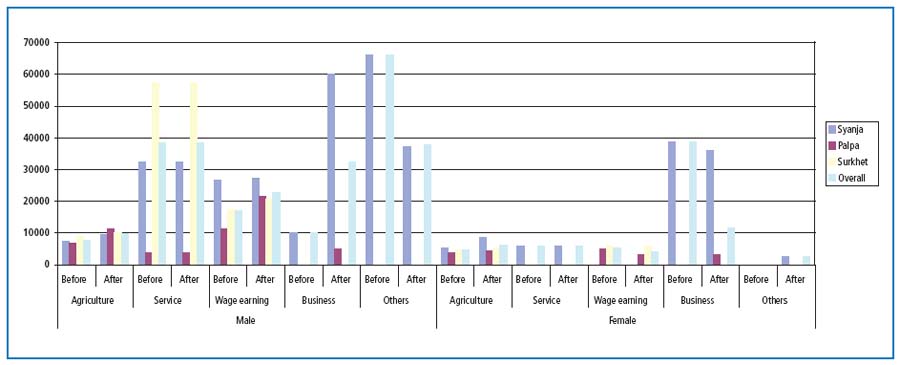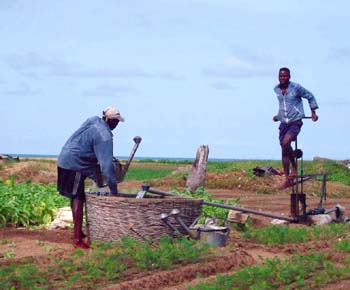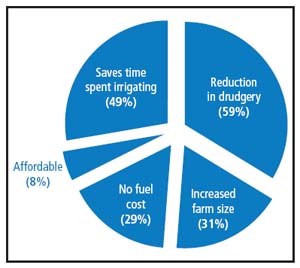Introduction
Numerous rivulets and springs provide promising opportunities for the development of small irrigation and water supply schemes in Nepal. Many such schemes were built under users’ initiatives and the users are benefiting from them for multiple purposes. Moreover, these small schemes are easily accessible to the poor and marginal households. Building on this trend, a few multiple use schemes were launched with the support from Nepal Smallholder Irrigation Market Initiative (SIMI), International Development Enterprises (IDE), and other donors. Multiple use water supply schemes provide water both for the household use and irrigation. All of these schemes are community-managed with substantial community participation. Assessment of the impact on gender of Multiple Use Water Systems (MUS) in the hills of Nepal is important. Therefore, this study assesses the gender dimension of MUS and presents preliminary findings.
Methods/Techniques of Data Collection
Focus group discussions (FGD) have been used for collection of primary information from six groups in three hill districts: Syangja, Palpa and Surkhet. The FGD were conducted by using a checklist prepared for the purpose. The participants were executive committee members and male and female users. To assess the impact on women and men, comparison of the “before” and “after” situation was also undertaken.
Multiple Use Schemes
The interventions in different locations have followed basically three strategies.
Irrigation schemes are completely new in each of the sites. But existing or abandoned drinking water schemes have been rehabilitated or combined as MUS. The technology used by the project includes one Thai Jar of 3 000 litres for drinking water. The overflow from this jar is collected in an underground tank of 10 000 litres for irrigation and distributed through offtakes at farmers field.

Major findings
Both men and women in the communities were positive about MUS as clean drinking water and irrigation facilities were available to grow vegetables through the pipe system.
Both men and women were consulted on problems and need identification and selection of the schemes. The SIMI irrigation technician consulted male and female members while doing the design and layout activities. Males and females were involved during construction. But it was found that most of the males participated in planning and decision making while women by large were involved in implementation. The discussions in different MUS groups reflected the division of labour between males and females. Mostly males participated in breaking stones and making walls while females were involved in carrying the sand and stone. All the six groups carry out the operation and maintenance work regularly once a month. Females clean the intake and water tank. Repair and maintenance like plumbing etc. were taught to male members only.
Active participation is a prerequisite for empowerment and promoting a real sense of ownership. Therefore, in order to assess the quality of participation of men and women in the programmes and organization, the participants were asked in which level the female members fit: a) passive recipients; b) participating in work planned by others; c) giving suggestions on needs and problems; and d) deciding and planning by participants. Most of the female members said that they participated as passive recipients and in work planned by others. Some women participated in giving suggestions on need and problems. Very few women were actively involved in the decision-making process.
Women in the communities were positive about water availability, because it considerably reduced the time needed for fetching water. With the introduction of MUS, they have saved two to three hours of time depending upon the size of the family and the distance to the water source.
Due to the availability of water for irrigation, farm activities have increased and women have time for vegetable farming which also generates some cash. However, they are so busy with the farm activities apart from household activities that they have less free time than before.

| Structure of income before and after introduction of MUS (NRs). | Source: Field survey 2005 ( USD = 70 NR) |
The income level of communities has increased with the introduction of MUS. The women, however, have less access to cash and have no control over their own earnings. The case is not the same for female-headed households. The following graph shows income of the households.
Both men and women have received training on various dimensions of growing vegetables. Some women reported that their self-confidence has increased through training.
It is found that the mobility of the women has increased, as they have to attend meetings from time to time in the absence of male members and have to go to market to sell vegetables.
The households' vegetable consumption has increased and this would certainly contribute to the improvement of their health.
Conclusion
Women's participation in MUS groups has increased but the number of women in decision-making roles in the MUS groups is very low. Although women have benefited, a greater effort is needed to achieve a better gender balance through increased women representation in decision making. This would have a positive effect on institutional development at the local level.
For more information contact: Dhruba Pant: [email protected] and Sabita Dhakhwa Shakya: [email protected]
Case of one
woman participant
Chuya Aryal lives in Senapuk Pelakot VDC 9, Syangja District. She is a mother of two daughters and two sons. She lives in a joint family with 12 family members. Her husband has a small shop in Galyang Market. She is educated up to fifth class. She was happy to have drinking water and irrigation facility supported by SIMI. Previously, she had to spend two to three hours just to fetch water in a day for domestic purposes and livestock. Now the saved time is utilized productively. As a member of a MUS group, she received training in raising vegetables and started to grow them. Previously they used to buy vegetable for consumption, now fresh vegetables are always available. She herself goes to market to sell vegetables. She received Rs 5 000/- by selling cucumbers in one season and Rs 8 000/- in another season. The income supports purchasing stationery and meals for her two daughters and sons for school. When asked who has access to the cash and who controls the income, she says, “I have to give the cash earned from vegetables either to my husband or my father-in-law. Sometimes my family will consult me to spend the money but I have no control over income.
Introduction
In West Africa, as in many other parts of the continent, erratic rainfall events, within and between years, has created uncertainty for rainfed agricultural producers and emphasized the need for irrigation. The traditional means of lifting water using rope and bucket is inadequate to meet the level of efficiency required. In response to this, the international NGO Enterprise Works (EW) introduced the treadle pump (TP) in the sub-region. The TP is a low-lift, high capacity, human powered water lifting pump which is designed to irrigate one hectare of farm land. The cost is low relative to motorized pumps and is intended to be accessible to farmers of all income classes constituting over 60 percent of the rural population in the sub-region.

Treadle pump usage in Lome, Togo.
Pump Manufacturing, Promotion and Marketing in West Africa: Strategies
Enterprise Works' involvement in the promotion of TPs in West Africa (WA) began during the early 1990s. In Senegal and Mali, dissemination began in 1995 and towards the end of 1996 about 1 900 and 600 pumps respectively had been produced in these countries. Other countries where EW has activities are Ghana, Niger, Guinea-Bissau, Benin, Côte-d'Ivoire, and Burkina Faso. The EW pumps are based on the Bangladesh model but modified for pressure delivery. Manufacturing of TP was essentially in the control of local trained manufacturers with functional workshops. EW gives the initial start-up support such as training, ensures quality control, and provides advertising skills, marketing strategy and after-sales care to enhance customer satisfaction and sustainability.
EW's promotion and marketing strategy is similar to private businesses, whereby radio, television, and public on-site/market demonstrations are used for dissemination of the products. Farmer-assisted sales are also adopted whereby an early adopter is encouraged to promote the technology among his or her neighbors in return for a sales commission from the manufacturer. EW encourages beneficiaries to purchase the pumps at fully unsubsidized prices directly from local manufacturers/sales agents without the intervention of the project. This marketing strategy has proved effective as is evident by the increase in the number of economic participants (defined as manufacturers, sales agents and farmers).
Number of Economic Participants of treadle pump in West Africa
| Country | 2002 | 2003 | 2004 |
| Benin | 4 383 | 5 043 | 4 486 |
| Burkina Faso | 4 371 | 6 850 | 9 074 |
| Ghana | 2 | 931 | 1 701 |
| Mali | 7 849 | 8 909 | 5 139 |
| Niger | 3 435 | 2 309 | 2 259 |
| Senegal | 2 629 | 1 972 | 1 479 |
Source: EW (2004)
Factors that have influenced the adoption of this technology, as revealed by a recent survey conducted by IWMI in Ghana, includes drudgery reduction (59 percent), reduction of time used for irrigation (49 percent), increased farm size (31 percent), no fuel requirement (29 percent) and affordability (8 percent), as seen in Figure. Factors given by non-adopters are: non affordability (58 percent), use of TP is labor intensive (31 percent), lack of suitability for cultivating large farm sizes (19 percent), lack of awareness (15 percent) and unreliability of their source of water (4 percent).

Treadle pump adoption drivers.
Impacts of Adoption
Currently, thousands of treadle pumps are being used by smallholders in West Africa. The number of sold pumps in the sub-region reached some of 8 469 with an annual income of US$349 per pump and a total economic benefit of US$20.9 million.
Several studies have documented the substantial increase in farm sizes due to adoption. Campbell and Lyman (2000) reported an increase of between 130 percent to over 200 percent. In Senegal farm sizes increased by 40 percent and irrigation time reduced from almost 12 person-hours per day to about 4 person hours per day. (Perry, 1997). However, in Ghana, about a 34 percent decrease in the total number of hours used in irrigation after adoption was reported (Kamara et al, 2004). In Niger a 23 percent decrease of labor time for adults (men and women) and 25 percent and 29 percent for male and female youths respectively, was reported (Naugle, 2000). In all, TPs had a significant positive impact on improving the efficiency of labor use.
EW's assessment reported that incomes of small-scale farmers have doubled due to labour savings, expansion of farm sizes and economies of scale (Enterprise Works, 2004). At a cost of between US$50 to US$100 per unit, the TP helps farmers to increase annual income derived from vegetable production. Increased farm sizes under irrigation and greater yields have made it possible for Senegalese market gardeners to generate annual net income gains of US$850, a return of 750 percent on the original investment of US$100 in the TP. A recent survey conducted by ANPIP (Agence Nigerienne de Promotion de l'Irrigation Privee) in Niger shows that with the use of TPs, the area under vegetable cultivation has more than doubled and annual net income of smallholder farmers has increased by a factor of 2.5 from US$232 to US$594. Generally, there has been an increase in farm incomes with farmers using the TP earning between US$230 and US$780 in increased annual net income (Enterprise Works, 2004).

IDE modified river pump, Zambia.
Challenges, Prospects and Suggestions for Sustainability
EW activities in the promotion of the technology in many WA countries have ended and it has become difficult to sustain the success achieved in some of these. Some of the problems highlighted in a recent survey in Ghana include the following: drop in sales of treadle pumps at the end of the EW project, farmers’ lack of skill for minor pump repairs, lack of proper maintenance after purchase and low level of awareness in some districts.
Treadle pump sales have prospects as shown by the increased sales records while EW was active. In addition, the material for the manufacture of the pump is available locally. Farmers have expressed willingness to adopt; but want provision for maintenance. To ensure the sustainability of the success achieved, there is a need for improved after sales service and a coordinating agency with longer term programme as is the case with Aprotec in East Africa.
For more information contact:
Dr. Boubacar BARRY
[email protected]
Dr. Adesola Olaleye
[email protected]
Dr.Adetola Adeoti
[email protected]